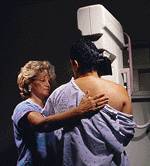
TUESDAY, June 11 (HealthDay News) — While the number of women dying from breast cancer is decreasing, mammography screening can’t take the credit, according to a new study from England that looked at 40 years of data.
“We find no effect of mammographic screening on population-based breast cancer mortality rates,” said study author Toqir Mukhtar, a researcher at the University of Oxford.
“While this does not rule out an effect at the individual level of women,” she said, “the key point is that these effects are not large enough to be detected at the population level.”
In their study, published June 11 in the Journal of the Royal Society of Medicine, the researchers found the greatest reduction in breast cancer deaths over the nearly 40 years studied was in women under 40, an age group not routinely offered screening.
Improvements in treatments and other factors may explain the decline, she said. Or, the benefits of screening may take a longer period of time to show up, she added.
However, Robert Smith, senior director of cancer screening at the American Cancer Society, disagreed that mammography doesn’t deserve the credit, and cited flaws in the new study.
Mukhtar’s team analyzed death rate trends from breast cancer before and after the introduction of the United Kingdom’s National Health Service Breast Screening Programme in 1988.
The researchers evaluated death statistics in the Oxford region. In that area, unlike the rest of the country, all causes of death are listed on the death certificate, not just the underlying cause. The investigators also compared that with death statistics for the whole of England.
The analysis in Oxford spanned the years 1979 to 2009. The analysis of national breast cancer death rates looked at the years 1971 to 2009.
Death rates began to decline before the 1988 introduction of screening, the findings indicated.
The researchers found no evidence that decreases in death rates were greater in women screened once, several times or not at all.
The new findings run counter to the results of other studies. For instance, the Marmot Report, commissioned by the English Department of Health and published in 2012, found a 20 percent relative reduction in breast cancer deaths in women offered screening.
Meanwhile, Smith and his colleagues reported in 2010 in the Journal of Medical Screening that screening was linked with a substantial reduction in breast cancer deaths in studies of Swedish and English women. That benefit in terms of lives saved is greater than the harm of overdiagnosis, with two or more lives saved for every overdiagnosis.
“We have more studies showing a benefit than those who don’t,” Smith said.
He also took issue with a statistical method used in the new study, in which researchers looked at breaks in patterns. “The researchers analyzed intervals that includes years before screening was offered and after,” he said. Ideally, they should have compared death rates before screening launched and after, he said.
Another point: “Some of the women who died from breast cancer after the screening program started had been diagnosed before mammography was even available,” Smith said, further complicating the analysis.
“We know mammography screening contributes to significant mortality reduction [from breast cancer] in the U.S.,” he said.
While individual U.S. organizations differ in specific mammography guidelines, including whether to start at age 40 or later and which intervals are best, they do agree on one point, Smith said: “Regular screening is a good thing to reduce your risk of dying from breast cancer and your need for a mastectomy.”
More information
To learn more about early detection of breast cancer, visit the American Cancer Society.

